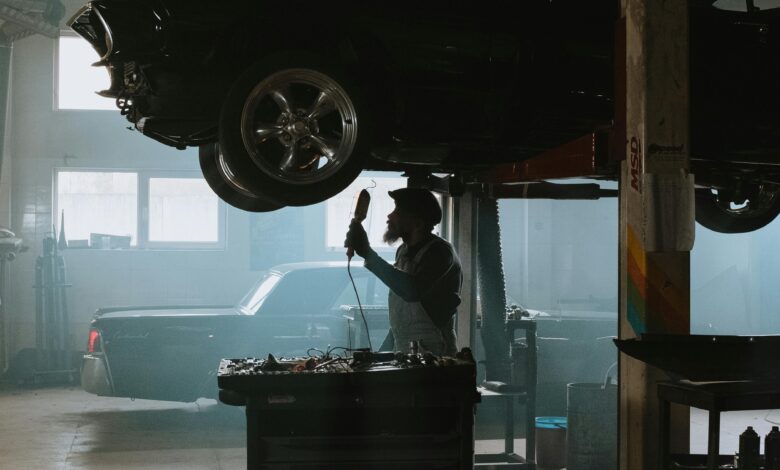To repair the car.

Owning a car can be a great convenience, but it also comes with the responsibility of maintaining it in good working condition. When faced with a car that needs repair, it is important to take the necessary steps to fix the issue promptly and effectively.
The first step in fixing a car is to accurately diagnose the problem. This may involve running diagnostic tests, inspecting the various components of the vehicle, and identifying the root cause of the issue. Depending on the nature of the problem, this could involve anything from a simple repair, such as replacing a flat tire or a worn-out part, to a more complex issue, such as a problem with the engine or the electrical system.
Once the problem has been identified, the next step is to gather the necessary tools and materials to address the issue. This may involve purchasing replacement parts, obtaining the appropriate tools and equipment, and ensuring that the work area is clean and organized.
The actual process of fixing the car can be a challenging and time-consuming task, especially for those who are not experienced in automotive repair. It may involve disassembling and reassembling various components, troubleshooting electrical systems, and performing intricate repair work. In some cases, it may be necessary to consult with a professional mechanic or to take the car to a repair shop for more extensive work.
Throughout the repair process, it is important to exercise caution and to follow all safety protocols to prevent injury or further damage to the vehicle. This may involve wearing protective gear, such as gloves and goggles, and ensuring that the work area is well-ventilated and free of any potential hazards.
Once the repair work is complete, it is important to test the car to ensure that the problem has been resolved and that the vehicle is operating safely and efficiently. This may involve taking the car for a test drive, checking for any remaining issues, and ensuring that all systems are functioning properly.
Overall, fixing a car can be a complex and time-consuming process, but it is an essential task for anyone who relies on their vehicle for transportation. By taking the necessary steps to diagnose and address the issue, and by following all safety protocols, car owners can ensure that their vehicle remains in good working condition and that they can continue to enjoy the convenience and independence that comes with owning a car.
To repair a car, one must first assess the issue at hand. This involves carefully inspecting the vehicle to identify the specific problem that needs to be addressed. This could involve checking the engine, transmission, brakes, or other components to determine the root cause of the issue.
Once the problem has been identified, the next step is to gather the necessary tools and materials required to fix the car. This may include items such as wrenches, sockets, screwdrivers, and replacement parts. It’s important to ensure that the correct tools and parts are used to avoid further damage to the vehicle.
With the tools and materials in hand, the repair process can begin. This may involve disassembling certain components, cleaning and inspecting them, and then reassembling them with the necessary adjustments or replacements. Depending on the complexity of the issue, this process can be time-consuming and may require specialized knowledge or expertise.
Throughout the repair process, it’s crucial to follow the manufacturer’s recommendations and guidelines to ensure the work is done correctly. This can involve consulting repair manuals, accessing online resources, or seeking the advice of a professional mechanic.
Once the repair is complete, the car should be thoroughly tested to ensure that the issue has been resolved and that the vehicle is safe and roadworthy. This may involve test driving the car, checking for any remaining issues, and making any necessary adjustments or fine-tuning.
Ultimately, repairing a car requires a combination of technical skills, attention to detail, and a methodical approach. By following the proper steps and using the right tools and materials, car owners can get their vehicles back on the road and running smoothly.
It was a sunny Saturday morning, and I had planned to go on a road trip with my friends. However, when I went to start my car, it wouldn’t turn over. Knowing that I needed to get it running before my friends arrived, I popped the hood and started troubleshooting.
First, I checked the battery connections to ensure they were tight and free of corrosion. After wiggling the terminals a bit, the car still wouldn’t start. Frustrated, I moved on to examining the spark plugs. Using a spark plug tester, I confirmed that the plugs were firing properly, ruling out an ignition system issue.
Next, I turned my attention to the fuel system. I listened closely as I tried to start the engine, and I couldn’t hear the familiar hum of the fuel pump. Suspecting a problem there, I traced the fuel line from the tank to the engine, checking for any leaks or blockages. Finding nothing obvious, I decided to check the fuel pump itself.
Removing the fuel pump access panel under the rear seat, I carefully disconnected the wiring and unbolted the pump. Bringing it inside, I tested it with a multimeter and, sure enough, the pump was dead. I quickly made a trip to the auto parts store to purchase a replacement.
With the new fuel pump installed, I reconnected the wiring and tried to start the engine again. This time, I heard the familiar whirring sound of the fuel pump priming, and the car roared to life! Relieved, I let it idle for a few minutes to ensure everything was working properly before taking it for a test drive around the block.
Thankfully, I was able to get the car running again just in time for my friends to arrive. We loaded up our gear and set off on our road trip, grateful that the morning’s mechanical troubles had been resolved.




